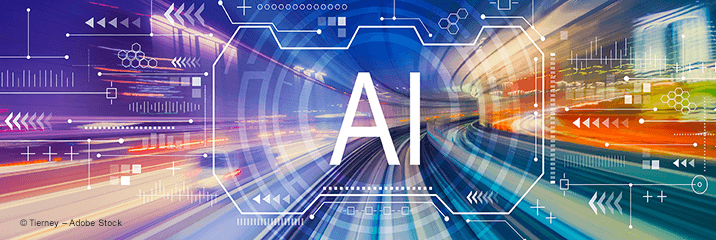Artificial intelligence – key technologies for the financial industry

From robots on the factory floor to decision-making in investment banks, technology has always driven the financial service sectors. John McCarthy first coined the term artificial intelligence in 1956, but for many this concept from the world of science fiction is only becoming a reality today.
The potential of this technology has driven billions of dollars into research and development around the world; however, there are no clear examples or benchmarks that show us exactly where we may end up regarding making machines think like humans.
Artificial intelligence (AI) is a crucial tool in the financial sector. AI covers everything from chatbot assistants to new systems and tools designed to quickly detect fraud. In addition, AI tools can be used to improve task automation in the financial industry, helping to increase efficiency. While AI may provide a lot of obvious advantages, it’s important to recognize that even now, a significant amount of a bank’s manual procedures are still being done manually.
Read moreTop 5 Common Training Data Errors and How to Avoid Them

In traditional software development, the code is the most critical part. In contrast, what’s crucial in artificial intelligence (AI) and machine learning (ML) development is the data. This is because AI training data models include multi-stage activities that smart algorithms must learn in order to successfully perform tasks .
In this scenario, a small mistake you make during training today can cause your data model to malfunction. This can also have disastrous consequences—for example, poor decisions in the healthcare sector, finance, and of course, self-driving cars.
So, what training data errors should we look out for, and what steps can you take to avoid them? Let’s look at the top five data errors and how we can prevent them.
Read moreEmotion Recognition – How computers see through our emotions

Emotion recognition or emotion detection is a method of detecting sentiments based on images, videos, audio, and text leveraging artificial intelligence (AI). In this scenario, technology uses data from different sources like photographs, audio recordings, videos, real-time conversations, and documentation for sentiment analysis.
Emotion recognition has become increasingly popular in recent years. In fact, the global emotion detection market is forecasted to grow to $37.1 billion by 2026.
Part of the “affective computing” family of technologies, the primary objective is to help computers or machines interpret human emotions and affective states. This is done by examining non-verbal forms of communication like facial expressions, sentence constructions, the use of language, and more.
Read moreArtificial Intelligence – Sentiment Analysis Using NLP

Artificial Intelligence is becoming more and more prominent in our everyday life. From Google Assistant to Apple’s Siri, we can interact with computers, smartphones, and other devices as if they were human beings.
However, while a computer can answer and respond to simple questions, recent innovations also let them learn and understand human emotions.
One of the latest uses of Artificial intelligence is sentiment analysis using natural language processing (NLP).Artificial intelligence for efficient support in translation work

Artificial Intelligence (AI) is becoming an ever more important part of our lives. Whether it is in our homes with smart speakers and automation or in the business world, its impact in our lives cannot be dismissed.
However, while the benefits of AI are obvious, in the past, using the technology with language translation was difficult, if not impossible. Language translation is an area that has always required human intervention. There’s simply too much nuance in language for a machine to understand without a lot of training, most often done painstakingly by hand.
In recent years, that situation has started to change. With new advances in Machine Learning (ML) along with the development of neural networks, this once-difficult task is now much more possible.
Read moreObject Detection and Segmentation

In recent years, object detection and segmentation have accelerated significantly. Today, smart algorithms can find and classify countless individual objects within a video or an image. Although it was incredibly difficult for machines to do, it’s now part of our daily existence.
Both object detection and segmentation are powered by Artificial Intelligence (AI), Machine Learning (ML), and Deep Learning (DL). In this scenario, convolutional neural networks can locate and identify the class each item belongs to within an image.
It has also evolved to be much more than an intelligent algorithm that can recognize objects in photographs stored in a database. It can now find and classify objects in real-time to enable things like self-driving autonomous vehicles and more.
Read moreHow to train AI Models effectively

When most people think about artificial intelligence (AI), they think of two possible futures. A positive future where self-driving cars help us navigate our roads and robot servants help us maintain our homes. Or a more negative one, where machines take away our jobs and employment.
Fortunately, it looks like the negative future isn’t one that we have to worry about. AI systems won’t replace humans in the workforce, but rather they’ll exist alongside humans as invaluable sidekicks. While self-driving cars are advancing towards commonality, other grand AI aspirations await realization. Integral to achieving these goals is understanding how to train AI models effectively.
Read moreHow Does Face Detection Work?

Face detection technology has come a long way over the past few years. From unlocking your iPhone by scanning your face to automatically tagging photographs, most of us have encountered and benefited from it (in one way or another).
However, there’s a lot more we can do with technology than just recognizing faces. For example, it is now a tool used in marketing to help improve sales and customer experiences. Or you can use this technology in offices to mark employee attendance or provide access to secure areas automatically..
But before we get ahead of ourselves, let’s define it.
Read moreThe development of face recognition technology and the role of adequate training data

Face recognition is a technology that is used to identify people by their faces and is a type of biometric software. It is often used in security settings, but also has other uses such as in social media and photo tagging.
In order for AI to be able to recognize a person by their face, it needs to be presented with enough training data, or data that shows the AI how to recognize people by their faces. The training data needs to be accurate, and it must be large enough to provide a large variety of examples.
Read moreSpeech Recognition Technology and Its Applications in Sales


Voice commerce has arrived. Today, retailers can sell products by designing experiences that leverage speech recognition technology and its capabilities.
According to Meticulous Research, wthe speech recognition market is forecasted to be worth approximately $26.79 billion by 2025 (growing at a CAGR of 17.2%). The number of voice assistants used around the world is also expected to reach a whopping 8.4 billion by 2024.
As such, speech recognition technology, like the dotcom boom, is well-placed to create a new avenue for sales teams around the planet. But before we get ahead of ourselves, let’s first define it.
Read more


